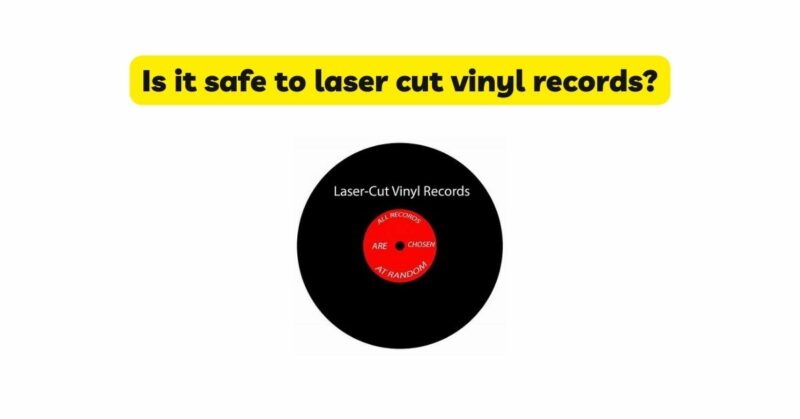Laser cutting has become a popular technique for crafting various materials, but when it comes to vinyl records, questions arise regarding the safety and feasibility of laser cutting. In this article, we will delve into the subject to provide insights into the potential risks and benefits of laser cutting vinyl records. We will explore the safety considerations, the process of laser cutting vinyl records, and the potential applications and limitations of this technique. Whether you are a vinyl enthusiast or a crafting enthusiast seeking innovative ways to repurpose vinyl records, read on to learn more about the safety aspects and possibilities of laser cutting vinyl records.
I. Safety Considerations
Before engaging in laser cutting vinyl records, it is crucial to understand and address the safety considerations associated with this process. Consider the following:
- Toxic Fumes: When laser cutting vinyl, it releases toxic fumes that can be harmful to human health. Vinyl contains chlorine, and when heated by the laser, it can produce chlorine gas and other hazardous byproducts. Proper ventilation and filtration systems must be in place to ensure the removal of fumes from the cutting area.
- Fire Hazard: Laser cutting generates intense heat, which poses a fire risk when working with flammable materials such as vinyl. It is essential to have fire safety measures in place, including fire extinguishers and fire-resistant surfaces.
- Eye and Skin Protection: Laser beams can cause severe eye damage. Protective eyewear specifically designed for laser use should be worn at all times during the cutting process. Additionally, protective gloves and clothing can prevent potential skin burns.
- Laser Safety Training: It is crucial to have a thorough understanding of laser safety protocols and receive proper training before attempting to laser cut vinyl records. Familiarize yourself with the laser equipment, its operation, and the safety precautions specific to the machine being used.
II. Laser Cutting Process
Laser cutting vinyl records involves several steps and considerations. Follow these guidelines for a successful laser cutting process:
- Preparation: Clean the vinyl record thoroughly to remove any dust, dirt, or debris that could interfere with the laser cutting process. Ensure that the record is free from any adhesives or stickers that may cause damage or produce toxic fumes when exposed to laser heat.
- Design Preparation: Create or import the desired design into the laser cutting software. Ensure that the design fits within the playable area of the record and does not compromise the structural integrity of the record.
- Laser Cutter Setup: Set up the laser cutter according to the manufacturer’s instructions. Adjust the laser power, speed, and other settings based on the thickness and type of vinyl record being cut. It is recommended to conduct test cuts on scrap vinyl or sacrificial records to determine the optimal settings.
- Ventilation and Extraction: Ensure proper ventilation in the cutting area to remove toxic fumes. Use a well-ventilated room or consider installing a dedicated ventilation system or fume extractor. Position the extraction system close to the cutting area to capture and remove the fumes effectively.
- Laser Cutting Execution: Place the vinyl record on the laser cutting bed, ensuring it is securely positioned. Start the laser cutting process, monitoring it closely to ensure that the cuts are precise and accurate. Avoid leaving the laser unattended during the cutting process.
- Post-Cutting Cleanup: Once the cutting is complete, remove the cut vinyl record from the laser cutter. Allow it to cool before handling. Clean the record again to remove any residue or debris resulting from the cutting process.
III. Applications and Limitations
Laser cutting vinyl records opens up a range of creative possibilities. Consider the following applications and limitations:
- Artistic Creations: Laser cutting allows for intricate and precise designs on vinyl records, making them ideal for creating unique wall art, decorative pieces, or customized record labels.
- Repurposing and Upcycling: Laser cutting provides a way to repurpose vinyl records that are no longer playable. By cutting them into various shapes and forms, they can be transformed into coasters, bowls, clocks, or even jewelry.
- Limitations: Laser cutting vinyl records has some limitations. The thickness and quality of the vinyl can affect the cutting results. Thick or low-quality vinyl may require multiple passes or higher laser power, increasing the risk of discoloration or warping. Intricate designs may also be challenging to cut due to the limitations of the laser cutting process.
IV. Safety Precautions and Best Practices
To ensure safety when laser cutting vinyl records, follow these precautions and best practices:
- Use Proper Ventilation: Ensure that the cutting area is well-ventilated to remove toxic fumes. Invest in a ventilation system or fume extractor designed for laser cutting operations.
- Wear Protective Gear: Use appropriate personal protective equipment (PPE) such as laser safety glasses and heat-resistant gloves to protect your eyes and skin from potential hazards.
- Fire Safety Measures: Have fire safety measures in place, including fire extinguishers and fire-resistant surfaces, to mitigate the risk of fire during the laser cutting process.
- Conduct Testing and Calibration: Test different settings and conduct trial cuts on sacrificial vinyl records or scrap material to determine the optimal laser power, speed, and other parameters for cutting vinyl records.
- Acquire Proper Training: Obtain training on laser safety and operation. Familiarize yourself with the specific laser cutting machine being used, its safety features, and the recommended procedures for cutting vinyl records.
Conclusion
Laser cutting vinyl records can be a creative and innovative way to repurpose these cherished items. However, it is essential to prioritize safety and take necessary precautions to mitigate potential risks. Understanding the safety considerations, following proper procedures, and using suitable protective gear are crucial for a safe and successful laser cutting experience. Always remember to work in a well-ventilated area, wear appropriate protective equipment, and have fire safety measures in place. By adhering to these guidelines, you can explore the possibilities of laser cutting vinyl records while ensuring a safe and enjoyable crafting experience.


